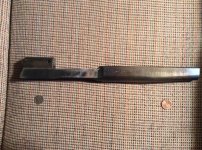If you ever wondered why the straight blowback action generally stops at 380, below is the picture why. This is the bolt from a Winchester 1907 semi auto rifle in 351WSL. It is a straight blowback design. Yes, it is a rifle. But it demonstrates the weight and size of the bolt required to withstand the higher pressures. The 351WSL is approximately the equivalent of a 357 magnum, maybe a little more. It propels a 180 grain projectile at close to 1900 FPS out of a 20 inch barrel. The coins are for scale. The bolt assembly weighs approximately 2 1/2 pounds. The spring that operates it is quite stiff.
Winchester made the 1910 in .401 WSL that propelled a 200 grain projectile at over 2000 FPS. Probably not going to put that in a hand gun.
So, what Hi Point did was actually a bit elegant considering the obstacles that have to be overcome. (Can you use Hi Point and elegant in the same sentence ?). And there are exceptions. I have an Astra 600 in 9mm Parrabellum that is a straight blowback that seems to work just fine. Not for the 'Dainty' but functional.
?). And there are exceptions. I have an Astra 600 in 9mm Parrabellum that is a straight blowback that seems to work just fine. Not for the 'Dainty' but functional.
Winchester made the 1910 in .401 WSL that propelled a 200 grain projectile at over 2000 FPS. Probably not going to put that in a hand gun.
So, what Hi Point did was actually a bit elegant considering the obstacles that have to be overcome. (Can you use Hi Point and elegant in the same sentence

